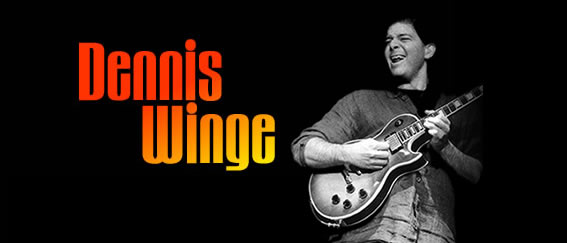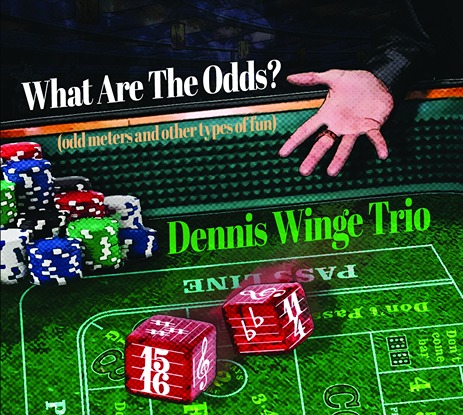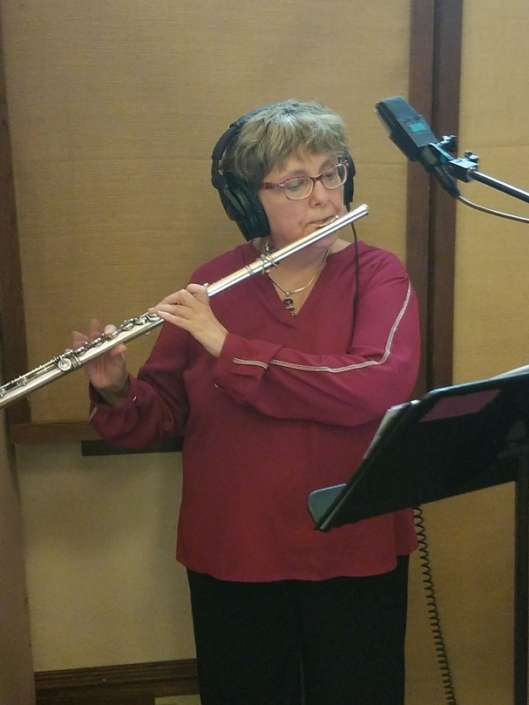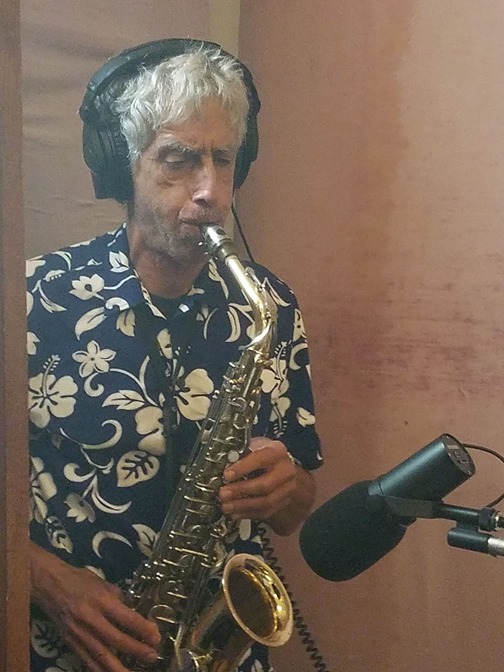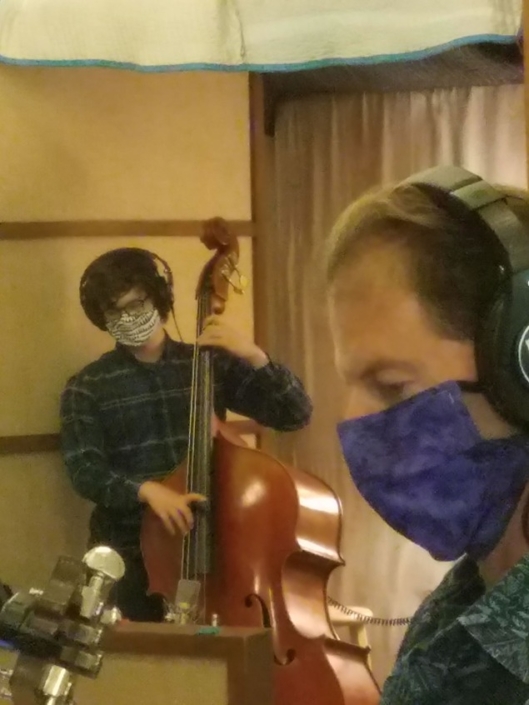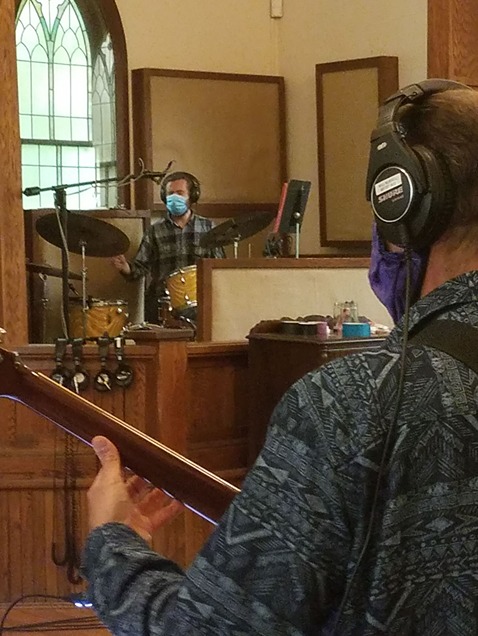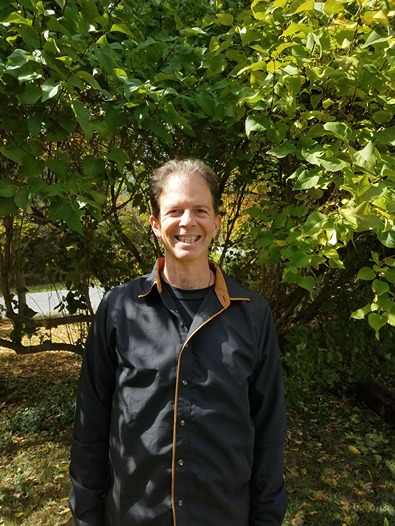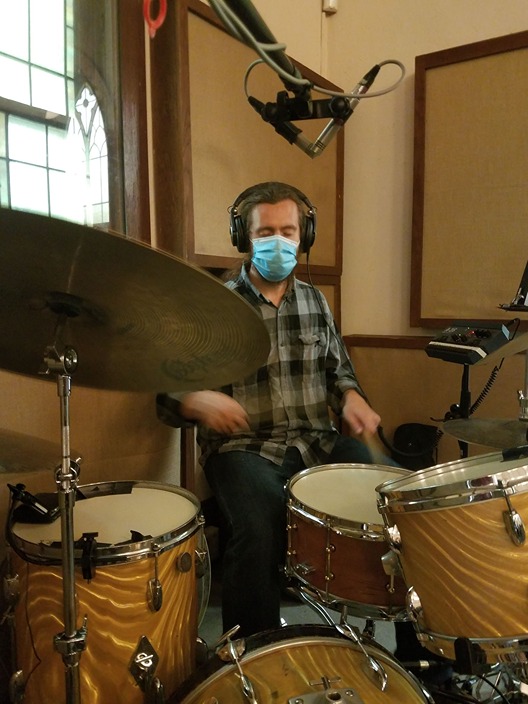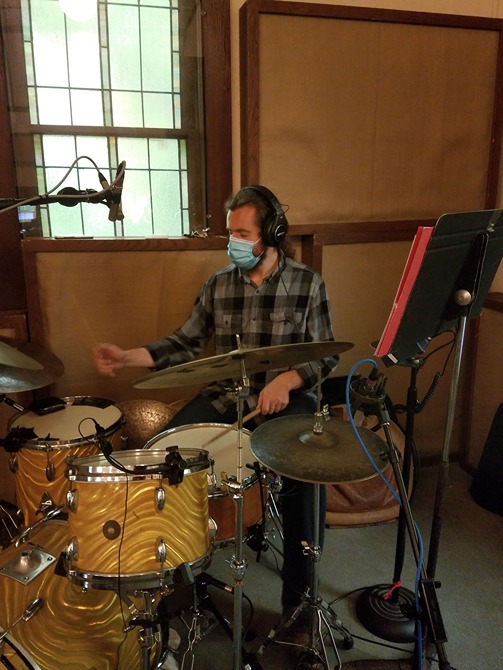What are the Odds?
Dennis Winge Trio and special guests
Dennis Winge’s… playing…[is] filled with creative jazz and displays his versatility along with plenty of surprises yet has a strong unity.
Winge has an original sound on his guitar… [On the album] there is a lot of variety, and the musicians are quite skilled at playing in unusual time signatures. The trio is quite tight with consistently close interplay between the musicians even when they essay tricky rhythmic pieces.
[Winge is a] talented guitarist-composer who is well worth discovering.
– Scott Yanow, jazz journalist/historian
© Copyright 2020 Dennis Winge
All selections composed by Dennis Winge, © 2020
“…most interesting combination of rhythm & down-home funky playing…tight trio
straight-ahead solos and pure raw energy…impressive variety of styles…MOST HIGHLY RECOMMENDED
– Dick Metcalf, editor, Contemporary Fusion Reviews
Playful playing. Even though you’re told ahead of time that the focus is on various beats and accents, the songs never feel like they are an exercise in gimmickry for its own sake.
– George Harris, Jazz Weekly
…an eclectic assortment of well-crafted songs…the guitar work here is exceptional…intelligent without being pretentious…more things to be discovered with repeated listening…reminds us that good music can also be good fun.
…an eclectic assortment of well-crafted songs…the guitar work here is exceptional…intelligent without being pretentious…more things to be discovered with repeated listening…reminds us that good music can also be good fun.
– Kyle Simpler, All About Jazz
Announcement
We are pleased to announce the release of Dennis Winge’s new album “What Are The Odds?” which features no less than 18 original compositions recorded live in the studio with bassist August Bish and drummer Kevin Cheli, plus two special guests.
Back Story
Dennis Winge is a professional guitarist who lives in Myrtle Beach SC. “What Are the Odds?” is his 6th instrumental album, the others being “One Small Step,” “Fly on the Wall,” “Just the One of Us,” “Come Out and Play” and “May Your Holidays Be Filled with Love.” Winge also has 4 albums of sacred chanting under his spiritual name Damodar Das (www.DamodarDas.com).
Description
“What are the Odds?” is a diverse assortment of adventurous yet accessible compositions by Dennis Winge whose inspirations are mostly rhythmic, and some of them are in odd time signatures such as 13/8 [Snowfall Romance, Third Teen], 15/16 [Window Shopping], and 11/4 [She is Free].
Personnel
Dennis Winge – guitars, compositions
August Bish – electric and upright bass
Kevin Cheli – drums and cymbals
Rob Weinberger – saxophone & Irish flute on disc 1 tracks 2, 9; disc 2 tracks 3, 9
Michele Gordon – flute on disc 1 tracks 4, 7; disc 2 tracks 5, 9
Credits
Recorded live at Electric Wilburland Studios in Newfield, NY on Oct 1 – 3, 2020
Mixed and mastered by Will Russell at above studio, October 2021.
Produced by Dennis Winge.
Cover artwork by Chris Chichester.
Liner notes & excerpts
Full Album Montage:
Move Over
Long before we recorded the album, I envisioned “Move Over” being its kick-off tune. Then while mixing I began to second-guess myself, so I asked my family to choose between this or 2 other possibilities, and they all chose this one! It’s an ideal choice because a) it’s in an odd time signature (7/4), b) it’s funky and relatively light-hearted, c) it characterizes the improvisational/ spontaneous nature of the recording, especially as it was recorded in one take.
Ses Vier
Rob Weinberger, the saxophonist on this and a few other selections on the album, has a wonderful, mostly instrumental band called “Unity Group.” I have really enjoyed subbing for the guitarist in that group now and then over the years because, as the name might imply, they play grooves from all over the world. One of my favorites is the African 12/8, which is way different from the kind a white guitarist from Long Island like me would grow up with. This tune was one of my original attempts at combining different rhythmic perspectives in 12, as in groups of 2s, 3s, 4s, or 7+5, for example
Lid Flipping
This tune was very fun to write because I had been playing around the Partido Alto groove from Brazil for a while when I discovered that Brazilian musicians commonly reverse the ‘clave.’ This means there is no actual downbeat on the “1” beat of every 2-bar cycle. I subsequently spent time digesting the tune “Partido Alto” made famous by Airto Moreira and also covered by Azymuth. If you are curious about the groove, check out the YouTube video I made about it for my guitar school Myrtle Beach Guitar Lessons by searching “Dennis Winge Partido Alto” on YouTube.
Khanda Blues
I suppose now is a good time to tell you about Konnakol, the South Indian counting language for music. I have been studying it a few years now, and to say there are so many things you can do with it is a total understatement. “Khanda” is the word for 5, and you’ll notice it has a very different feel from a more ‘Western’ 5/4 groove such as Dave Brubeck’s “Take Five.” The feel is “ta-ge–,ta-ge–” or two sets of 5 eights notes per bar, where the first and third of each set of 5 are accented. Nice job Michele Gordon did on flute on this one, also recorded in a single take.
She is Free
There is one small section of this tune’s melody, from about 0:17 to 0:25 on the recording, that reminds of the Beatles’ song “She’s Leaving Home,” even though I wasn’t thinking about that tune while I was composing it. “Quietly turning the backdoor key, stepping outside she is free…” Incidentally, there is another bit that reminds me of “Three Gymnopédies” by Erik Satie; it’s from 0:34 to 0:43 or so. This slow 11/4 groove was challenging for me. Thankfully, I was supported beautifully, as is the case on the entire album, by my always ready-willing-and-able rhythm section.
5 & 9 Go to 4’s House
When you take four bars of 4/4 and divide each bar into 16th notes, that’s a total of 64 beats. Somehow it occurred to me that you can divide into 6 bars of 9/8 (54 beats), plus two bars of 5/8 (10 beats), and that’s how the tune got started. It’s really quite a silly title, and it made me chuckle for a while after naming it that. A lot of the tracks on this album have very simple harmony, because all my mental bandwidth was consumed by the rhythmic aspects, and this is tune is one of them.
Mambo Delicioso
I absolutely love the mambo feel. Many people call it “salsa,” but I heard that Tito Puente always said that that word should be reserved for that which you eat with tortilla chips, so ever since then I have used the word mambo. Because the album is largely trio work, this is one of the few tunes that I got to “comp” (play rhythm guitar) for an instrument other than bass, which of course in this case was Michele Gordon’s stylistically fitting flute lines.
Window Shopping
When the studio owner heard the opening I maj – bVII maj progression, we all started citing famous songs that have that progression. The one I always hear is the Allman Brothers “Ain’t Wasting Time.” I actually wrote this tune a while ago and played it at the CD release concert of my previous album “One Small Step.” You have to be careful because, being in 15/16, it’s easy to slip into 4/4, as it’s only one sixteenth note away. Not sure what about this tune made my wife thinking of window shopping, but that’s what she came out with when I asked her what visual she got when I was ‘shopping’ for a title.
Let’s Fly
Jazz musicians will get the reference of the title here, which doesn’t just refer to the tempo. It’s a nod to the tune it was based on which is “Fly Me to the Moon.” I wish I could play up-tempos as fluidly as Kevin Cheli and the lads, but such was the reason for writing the tune in the first place. Now you know one of my secrets why I write the way I do: I want to improvise in that tune’s groove / tempo / time signature / chord changes, and the writing of the tune gives me the excuse to do so. I suppose this is not really a secret at all, but common among jazz musicians.
Monkey Cage
I had never really played in 9/4 or 9/8 prior to the writing and recording of this tune. In this particular case, we divided it as 2+2+3+2 quarter notes for the main section, and 2+2+2+3 plus 2+2+2+3 eighth notes for the interlude. I don’t think I named the tune as I did for this reason, but every time I hear or play the opening phrase, I hear the lyric “Monkey Cage” in my head now.
Third Teen
I really love the app Drum Genius. I have even corresponded with its creator, a bassist who lives in Italy, a few times, thanking him of course. This tune is one of several that were inspired by grooves on this app, the very first of which was the tune “Mauritian Sega” which I wrote for the debut album from Not From Brooklyn. The groove for this tune is one Drum Genius describes as “funky 13/8 a la Gaetano Fasano.”
Celtic Reverie
There was a time, following my fourth or fifth visit to Ireland, when I got really into Irish music. Not only did I spend a significant amount of time with traditional Irish jigs and reels, but also more broad “Celtic” music by various artists throughout all the other parts of the islands. For example, I have always loved Maighread Ni Dhomhnaill’s version of “Amhran Pheadar Breathnach” and did a solo guitar version of it on my album “Fly on the Wall.” I guess the rock territory in my solo on “Celtic Reverie” came from being influenced by Irish bands like The Corrs, Young Dubliners, and the Pogues as well.
Duelism
The reason this title is not spelled “dualism” is because I originally thought of it as a duel between two harmonic reference points. Every 4-bar cycle oscillates between equal portions of Gb lydian and C dorian #4. They don’t really duel though because they are a tritone apart and both scales have the #4. This was perhaps the most difficult of all the “heads” (melodies) on the album; it took me ages to work it out with harmonic accompaniment as well, which you have to do when you’re playing in a trio setting.
Middle Earth’s Cry
This tune is based on a simple 7-note Indian ‘thaat’ (loosely, a scale on which a raga is based.) Michele and I have played lots of kirtan (chanting) events together, and the ‘Todi bhav’ that is used here is also on the opening track of my album, “Official Bootleg.” I’ve also used this and other ‘thaats’ on a few of my 121 versions of the Hanuman Chalisa and on “Puravi Sketch” from my album, One Small Step, which was the favorite track of the reviewer at JazzGuitar.com who wrote a glowing review of the album. The slow ¾ tempo was inspired by a Carnatic concert that my son and I went to at Cornell. I love the chaos that happened in the middle section.
Snowfall Romance
I can’t remember why, but we chose to record this track first in the studio at the beginning of that two-and-a-half day adventure. The engineer, Will Russell, said that when he read that we were going to attempt to record 18 tracks in 3 days, he laughed out loud. Fortunately, this first tune was recorded fairly quickly, and when he asked me if we wanted to listen back, I said “no” and it was on to the next tune! Ever since I moved to the area, I always and only refer people to Electric Wilburland. The tune is based on rhythm changes, key of Eb, in 13/8. Nice solo by August Bish.
The Nardisian
Nardis is a well-known tune by Bill Evans that was accredited to Miles Davis. I always love playing that tune, especially with the opening vamp that Mike Stern put on it. I remember, at the time of writing “The Nardisian,” being proud of using all 12 notes in the melody. Highlights for me include the changes being expertly handled by Rob Weinberger in his solo and Kevin Cheli doing his full-on Elvin Jones style. I told him later that, unlike many gigs where he has to play reservedly due to volume concerns, I enjoyed hearing him “smash up the kit” (the technical term for playing aggressively.)
Maravillosa
If you are a musician who likes to play Latin jazz, I highly recommend a play-along book called “Muy Caliente.” I love this book; the grooves are fantastic and the musicians are outstanding. I have since sought out albums by some of the members such as bassist Oscar Stagnaro and pianist Rebecca Mauleón. In any case, I got the idea for the harmony of “Maravillosa” from a track on that play-along album/ book. As for the title, I was searching for something ‘sexy’ and I had already used “Delicioso” in a different tune, as we have seen.
Up Every 24 Blues
Perhaps the only really straightforward tune on the album, being a blues in 4/4 swing and all, “Up Every 24 Blues” makes up for it by modulating up in key every 24 bars. This means that the “out-head” could start in any key, and we don’t know until we get there what that will be. It was fun to play as a quintet, with Rob, Michele & I each taking 2 choruses before trading with Kevin. Before we go, let me just publicly say a big thank you to Will Russell, Rob Weinberger, Michele Gordon, Kevin Cheli, and August Bish! You guys are the best; on par only with you who are reading this. 🙂
Critical Acclaim for “What Are the Odds?”
Review of “What Are The Odds?”
by Scott Yanow, jazz journalist/historian
Guitarist Dennis Winge has certainly had a wide-ranging career. Currently he leads a jazz ensemble, a rock cover group, a blues band, an electric chant group, a Steely Dan cover band, and a duo with flute, in addition to playing unaccompanied solos. His recent double-CD, his sixth instrumental set as a leader, is filled with creative jazz and displays his versatility along with plenty of surprises yet has a strong unity.
What Are The Odds consists of 18 of the guitarist’s originals. Winge and his trio with bassist August Bish and drummer Kevin Cheli is joined by Rob Weinberger (doubling on alto-sax and Irish flute) and flutist Michele Gordon for four numbers apiece including one (“Up Every 24 Blues”) that includes both of the guests. Immediately apparent when listening to this enjoyable set is that Winge has an original sound on his guitar, there is a lot of variety, and the musicians are quite skilled at playing in unusual time signatures; Bish and Cheli sound effortless and inspired during both their attentive accompaniment and concise solos. The trio is quite tight with consistently close interplay between the musicians even when they essay tricky rhythmic pieces.
The set begins with the happily funky “Move Over” which is in 7/4 time. “Ses Vier” sounds like it is Eastern European in its melody and rhythms while “Lid Flipping” is high-quality fusion with Winge utilizing a rockish sound. “Khanda Blues,” which has fine flute playing from Michele Gordon, is a blues but the eccentric rhythmic accents keep it from ever being predictable. “She Is Free” is a particularly strong and moving ballad with lyrical guitar and bowed bass while “5 & 9 Go To 4’s House” has a title that refers to the time signatures which shift regularly throughout the piece. “Mambo Delicoso” sounds like classic Brazilian jazz and the relatively relaxed “Window Shopping” (in 15/16 time) takes listeners on a leisurely journey before the boppish “Let’s Fly” closes the first half with an uptempo romp that includes Weinberger on alto.
The quality, variety and momentum do not slow down during the second half of What Are The Odds. “Monkey Cage” is danceable to those who can do a foxtrot in 9/8 time. The group sounds particularly tight during the fusionish “Third Teen.” “Celtic Reverie” could easily pass for song from Ireland with its melody and flute; Winge contributes a bluesy solo. “Duelism” displays plenty of energy and agility while “Middle Earth’s Cry” has a lengthy and atmospheric theme that could be used for meditation before the improvising becomes explorative. “Snowfall Romance” has particularly fluent jazz guitar playing with the trio. “The Nardisian” has a fiery Spanish groove that is a little reminiscent of Chick Corea’s “Spain” but develops its own themes along the way. The program concludes with the quirky but catchy “Maravillosa” and “Up Every 24 Blues” which features the full quintet.
What Are The Odds displays some of the many musical sides of Dennis Winge, a talented guitarist-composer who is well worth discovering.
TIME IN…Dennis Winge Trio: What Are The Odds?
by George W. Harris, Jazz Weekly
Guitarist and composer Dennis Winge subtitles this 2-disc trio outing with August Bish/bass and Kevin Cheli/drums “Odd Meters and Other Types of Fun,” showing his hand of playing in and with different time signatures. Sort of like a rock trio version of Dave Brubeck, Winge’s trio also brings in some guests, such as Rob Weinberger for his tenor sax work on the Middle Eastern-pulsed “Ses Vier” and hip “Up Every 24 Blues” and his flute for the Gaelic “Celtic Reverie” while Michel Gordon loans out her flute to team with Bish’s bowed bass on “Khanda Blues” and funky “Middle Earth’s City”.
The trio itself delves into some 70s rock on “The Nardisian” and Winge plugs in to the backbeat of “Move Over” while swaying to Bish’s bass on “Mambo Delicioso.” Bish and Cheli deliver some clever interplay on the conversant “Duelism” and are joyfully frantic under Winge’s strings on “Maravillosa.” Cheli’s sticks snaps everyone to attention as Winge digs in on “Lid Flipping” while the leader is lyrical on “Snowfall Romance.” Even though you’re told ahead of time that the focus is on various beats and accents, the songs never feel like they are an exercise in gimmickry for its own sake. Playful playing.
Timely tasty jazz guitar trio Dennis Winge Trio – What Are The Odds
by Dick Metcalf, Contemporary Fusion Reviews
Timely tasty jazz guitar trio Dennis Winge Trio – WHAT ARE THE ODDS: When I reviewed Dennis’s “One Small Step” album in early 2019, I was very much impressed by the variety of styles presented… on his new double CD, you’ll enjoy some of the most timely & tasty jazz you’ve ever listened to… to get a sampling of the amazing the trio does, I (most strongly) suggest that you watch this live performance video first…
…since you’re there already, be sure to SUBSCRIBE to the Dennis Winge YouTube channel, so you can explore the MANY other performance and instructional videos posted there… I’ve been subscribed for over a year now.
On tunes like “Monkey Cage”, you’ll find a most interesting combination of rhythm & down-home funky playing that your ears will keep coming back to again & again… Dennis’s lead and the superb bass work are synced up perfectly… I predict DJ’s of all stripes around the globe will be spinning this song often!
I totally dug down deep on “Lid Flipping”… solid guitar licks from Dennis with tight trio action all the way through this 6:19 gem… straight-ahead solos and purely raw energy made it an easy choice for placement on my iPhone player (reserved for only the very best).
One of the most impressive things about Dennis’s albums is the variety of styles you’ll hear… I immediately fell in love with the captivating Latin jazz vibe on “Mambo Delicioso”… very impressive flute work on this tune!
It took me two spins through all eighteen songs on the double CD, but it was actually easy to make my choice for personal favorite… the closer on the album, “Up Every 24 Blues”, has a totally lovely vibe & more of that (very) attractive flute… one of the best jazz performances I’ve listened to (yet) in 2021.
I give Dennis and his players a MOST HIGHLY RECOMMENDED rating, with an “EQ” (energy quotient) score of 4.99 for this high-energy jazz adventure. Get more information on Dennis’s website as it becomes available. Rotcod Zzaj
“What Are The Odds?” Review
by Kyle Simper, All About Jazz
Even though a lot of recorded music relies on “comfort zone” time signatures like 4/4 or 3/ 4, many musicians still like exploring more unusual time signatures. Probably the most notable example of this rhythmic experimentation is Dave Brubeck’s landmark 1959 album Time Out. Considering that this is one of the most popular albums in jazz shows that music in unusual key signatures can be very appealing. This is also the case with guitarist Dennis Winge. His album, What Are The Odds?, features an eclectic assortment of songs written in a variety of different time signatures, and the experiment paid off.
Dennis Winge is a guitarist based [Myrtle Beach SC] whose experience is as diverse as the time signatures featured on this album. His musical projects include a jazz group, rock cover bands, a blues band, and sacred chanting. Winge also provides guitar instruction, and he has a YouTube channel. For this album, he is joined by August Bish on bass and Kevin Cheli on drums. Along with the core group, What Are The Odds? also features guest appearances by Rob Weinberger on saxophone and flute and Michele Gordon on flute.
The subtitle of the album is “odd meters and other types of fun,” which is a fairly accurate description of what’s in store. There’s quite a bit of variety in the tempo department, but Winge’s diverse musical background also comes across in full force on this double album. What Are The Odds? is filled with a wide range of styles, including fusion, blues, funk, and world music influences as well.
Winge wrote all of the material on the album, and each song is well crafted. However, he is a guitarist first and foremost, and the guitar work here is exceptional. His tone varies depending on the context of the music. Some songs, like “Snowfall Romance,” have a very straight-ahead guitar sound, while compositions like “Move Over” have a driving fusion sound with just the right amount of distortion.
The material on What Are The Odds? also features a variety of global flavors. “Ses Vier,” for example, is inspired by African rhythms. Rob Weinberger’s sax along with Winge’s guitar provide a funky groove that seems somewhat reminiscent of Ghanaian highlife music. Songs like “Khanda Blues” or “Middle Earth’s Cry” offer an interesting mixture of jazz and Indian music. The album also includes selections with Latin and Celtic elements as well.
Although Winge’s compositions do often venture away from the beaten jazz paths, he doesn’t abandon traditional forms altogether. “Up Every 24 Blues,” for example, features a straightforward blues in 4/4. Okay, there are still a few unexpected twists here. The song modulates every 24 bars, remaining true to the album’s playful quality.
What Are The Odds? is a diverse collection of music that lifts the spirits. It’s intelligent without being pretentious. Also, like any other good art form, whether it’s film or poetry, there are more things to be discovered with repeated listening. Probably the most important aspect of this album, though, is how it reminds us that good music can also be good fun.
